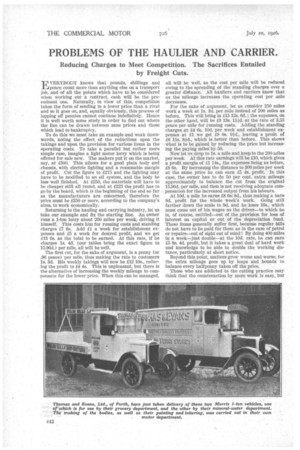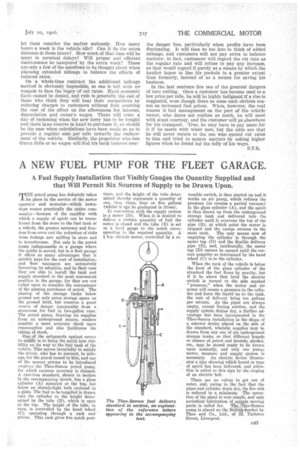PROBLEMS OF THE HAULIER AND CARRIER.
Page 26

Page 27

If you've noticed an error in this article please click here to report it so we can fix it.
Reducing Charges to Meet Competition. The Sacrifices Entailed by Freight Cuts.
EVERYBODY knows that pounds, shillings and pence count more than anything else on a transport job, and of all the points which have to be considered when working out a contract, cash will be the preeminent one. Naturally, in view of this, competition takes the form of sending in a lower price than a rival and so it goes on, and, equally obviously, this process of lopping off pennies cannot continue indefinitely. Hence it is well worth some study in order to find out where the line can be drawn between sane prices and those which lead to bankruptcy.
To do this we must take an example and work downwards, noting the effect of the reductions upon the takings and upon the provision for various items in the operating costs. To take a parallel but rather more simple case, imagine a light motor lorry which is being offered for sale new. The makers put it on the market, say, at £300. This allows for a good plain body and chassis, with electric lighting and a reasonable margin of profit. Cut the figure to £275 and the lighting may have to be modified to an oil system, and the body be less well finished. At £250, the materials will have to be cheaper still all round, and at £225 the profit has to go by the board, which is the beginning of the end so far as the manufacturers are concerned, therefore the price must be £250 or more, according to the company's aims, to work economically.
Returning to the hauling and carrying industry, let us take our example and fix the starting line. An owner runs a 1-ton lorry about 200 miles per week, driving it himself. This costs him for running costs and standing charges £7 6s. Add £1 a week for establishment expenses and £5 a week for desired profit, and we get £13 6s. as the total to be earned. At this rate, if he charges is. 4d. (our tables bring the exact figure to 15.96d.) per mile, all will be well.
The first cut, for the sake of argument, is a penny (or .96 pence) per mile, thus making the rate to customers is. 3d. His weekly takings will now be £12 10s., reducing the profit to £4 4s. This is unpleasant, but there is the alternative of increasing the weekly mileage to compensate for the lower price. When this can be managed,
all will be well, as the cost per mile will be reduced owing to the spreading of the standing charges over a greater distance. All hauliers and carriers know that as the mileage increases the operating cost per mile decreases.
For the sake of argument, let us consider 250 miles work a week at 1s. 3d. per mile instead of 200 miles as before. This will bring in £15 12s. 6d.; the expenses, on the other hand, will be £3 13s. 1141. at the rate of 3.55 pence per• mile for running costs. Adding the standing charges at 14 Os. 10d. per week and establishment exPenses at £1 we get £9 Os. 9id., leaving a profit of £6 11s 8d., which is better than before. This shows what is to be gained by reducing the price but increasing the paying miles by 50.
Now let us drop to 1s. a mile and keep to the 200 miles per week. At this rate earnings will be £10, which gives a profit margin of 11 148., the expenses being as before, £8 Os. By increasing the 'distance to 300 miles per week at the same price he can earn £5 4s. profit. In this case, the owner has to do 50 per cent, extra mileage approximately to balance the cut from the original 15.96d. per mile, and then is not receiving adequate compensation for the increased output from his labours.
At 10d. a mile he earns £8 6s: 8d., thus making a bare 8d. profit for the whole week's work. Going still farther down the scale to 9d. and he loses 16s., which must come out of his wages as the driver—to which he is, of course, entitled—out of the provision for loss of interest on capital or out of the depreciation fund. These items generally suffer first, because regular bills do not have to be paid for them as in the case of petrol or repairs—out of sight out of mind! By doing 400 miles in a week—just double—at the 10d. rate, he can earn £5 8s. 4d. profit, but it takes a great deal of hard work and knowledge to be able to double the working distance, particularly at short notice.
Beyond this point, matters grow worse and worse, for the extra mileage goes up by leaps and bounds to balance every halfpenny taken off the price.
Those who are addicted to the cutting practice may think that the counteraction by more work is easy, but
let them consider the matter seriously. How many hours a week is the vehicle idle? Can it do the extra distance in those hours? How much of that time will be spent in terminal delays? Will proper and efficient maintenance be hampered by the extra work ? These are only a few of the questions to be thought about when planning extended mileage to balance the effects of reduced rates.
On a whole-time contract the additional mileage method is obviously impossible, so one is left with no weapon to face the bogey of cut rates. Hard economic facts cannot be denied, and ruin is generally the end of those who think they will beat their competitors by reducing charges to customers without first counting the cost of the effect on the allowances for interest, depreciation and owner's wages. There will come a day of reckoning when the new lorry has to be bought and there is no reserve in hand to purchase it, as should be the case when calculationshave been made so as to provide a regular sum per mile towards the replacement of the vehicle. Similarly, the proprietor who has drawn little or no wages will find his bank balance near the danger line, particularly when profits have been fluctuating. It will then be too late to think of added mileage, and customers will not pay extra to balance matters : in fact, customers will regard the cut rate as the regular rate and will refuse to pay any increase, as they would regard it purely as a means by which the haulier hopes to line his pockets to a greater extent than formerly, instead of as a means for saving his business.
In the last sentence lies one of the greatest dangers of rate cutting. Once a customer has become used to a low price per mile, he will be highly indignant if a rise is suggested, even though there be some such obvious reason as increased fuel prices. When, however, the real reason is bad management on the part of the vehicle owner, who dares not confess as much, he will meet with scant courtesy, and the customer will go,elsewhere for his transport. True, he may have to pay more for it if he meets with wiser men, but the odds are that he will never return to the one who quoted cut rates to him and tried to square matters by asking higher figures when he found out the folly of his ways. '
S.T.R.






























